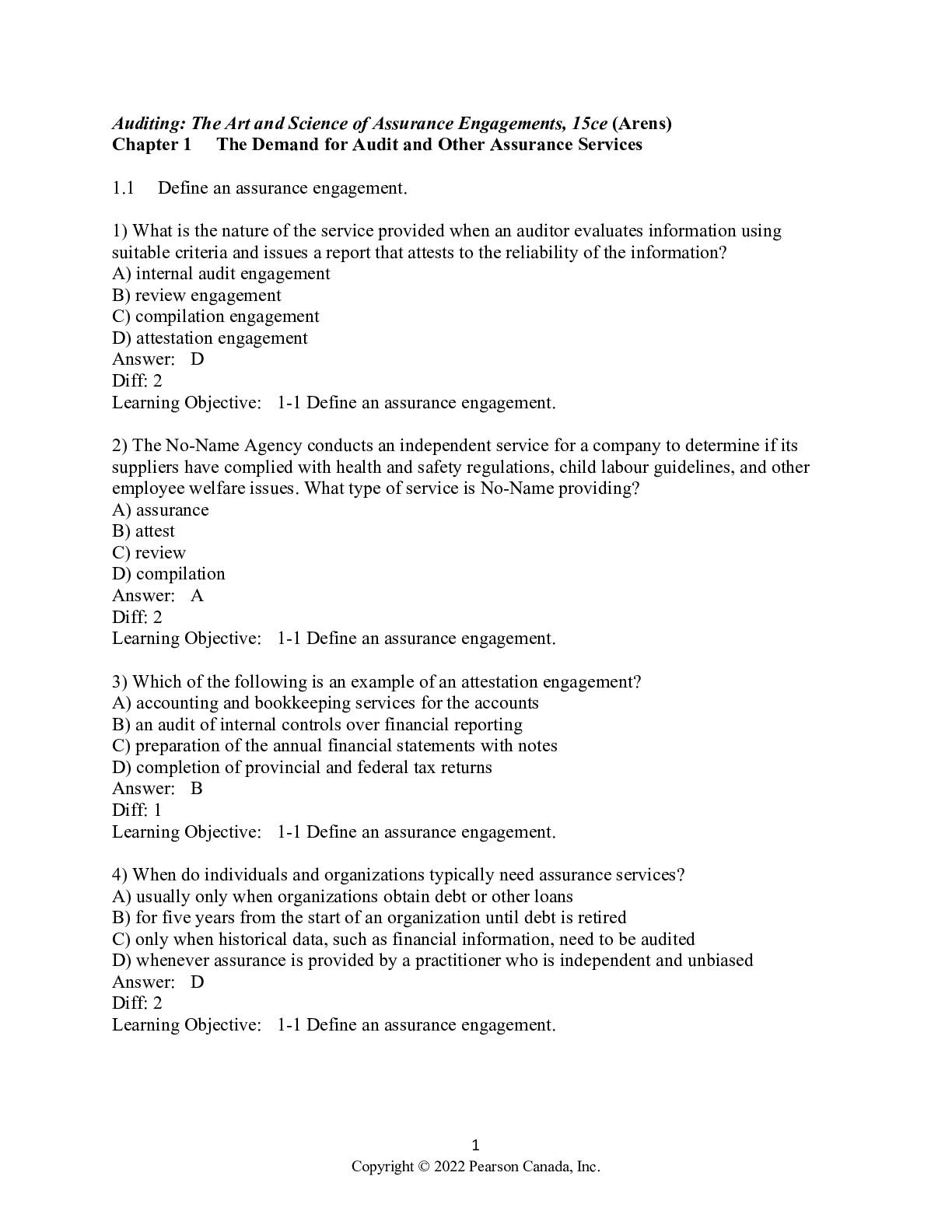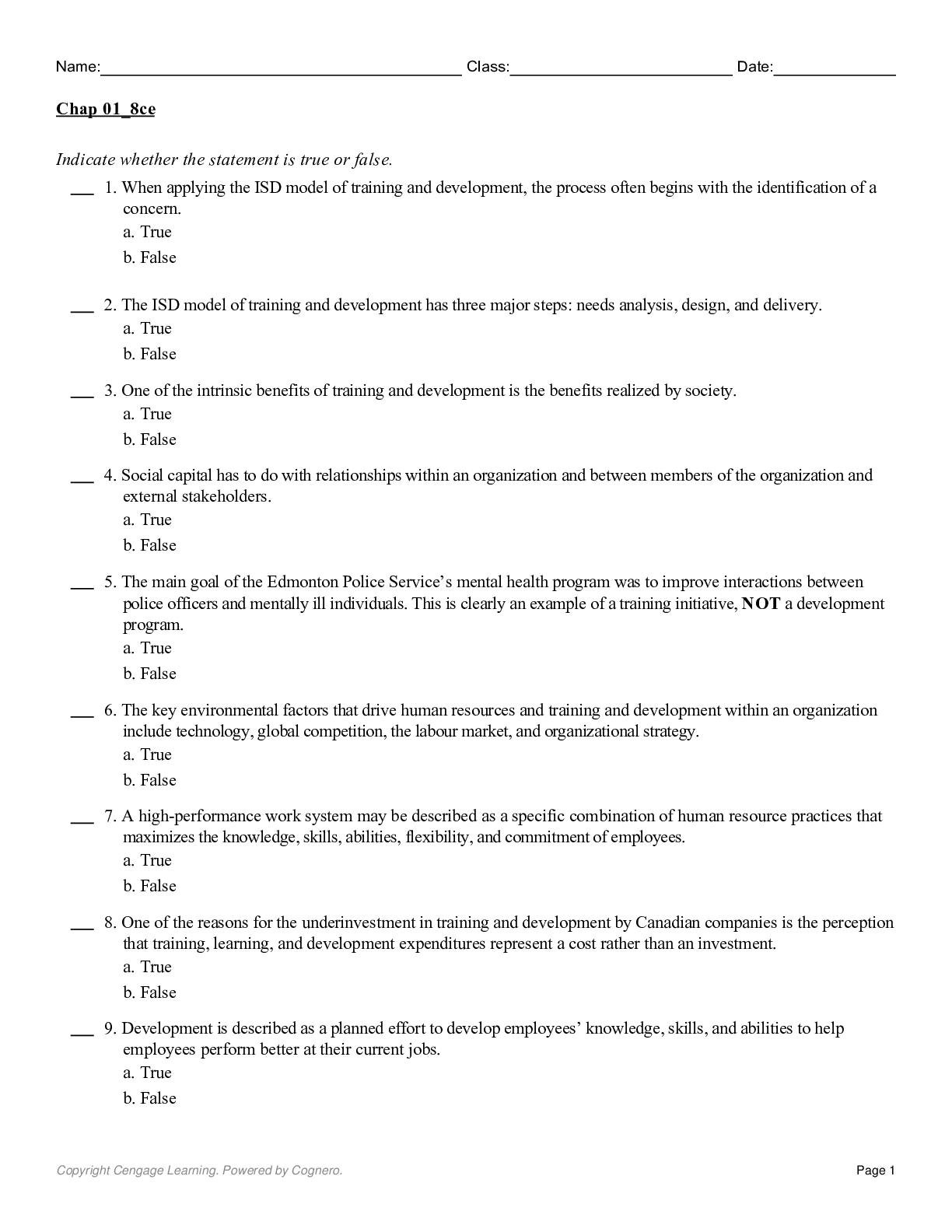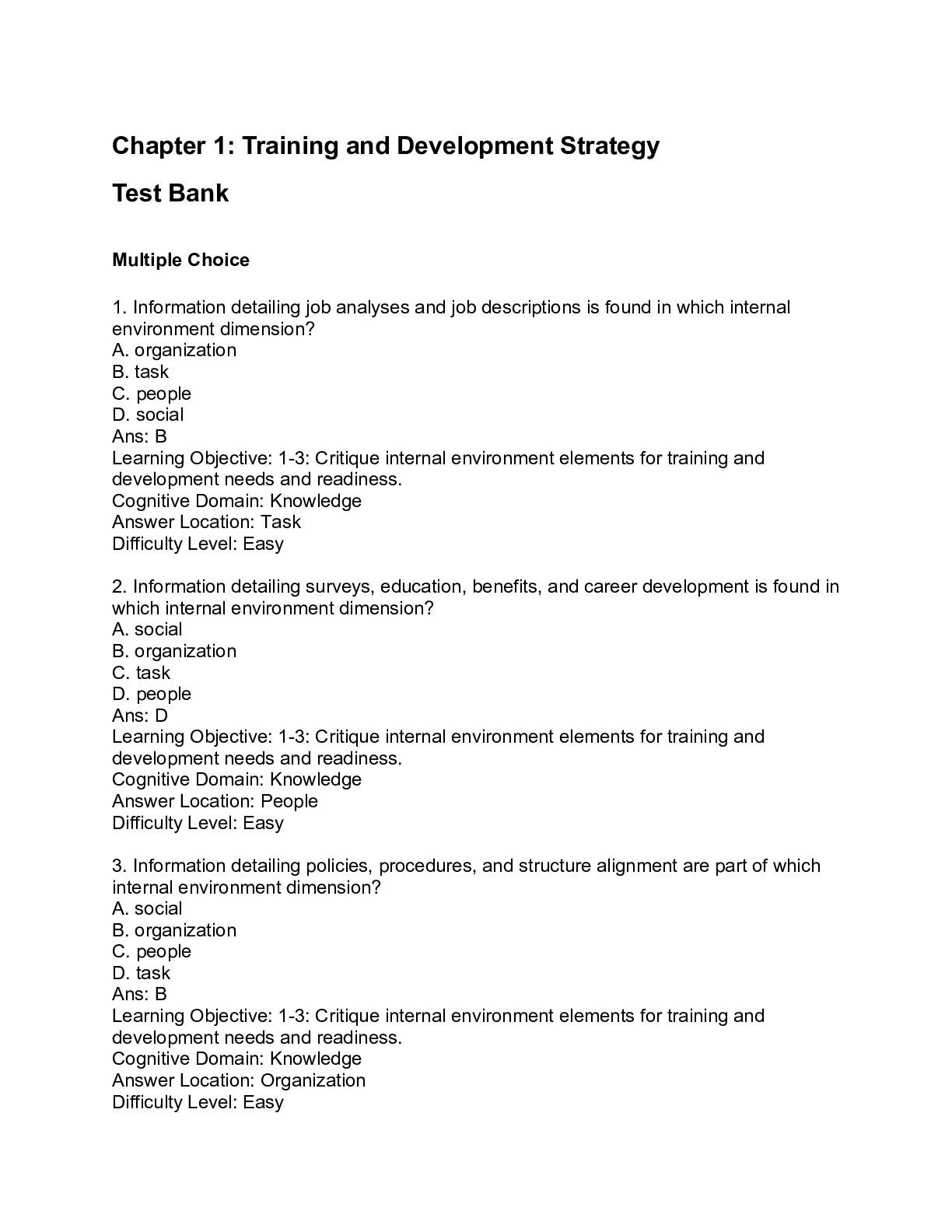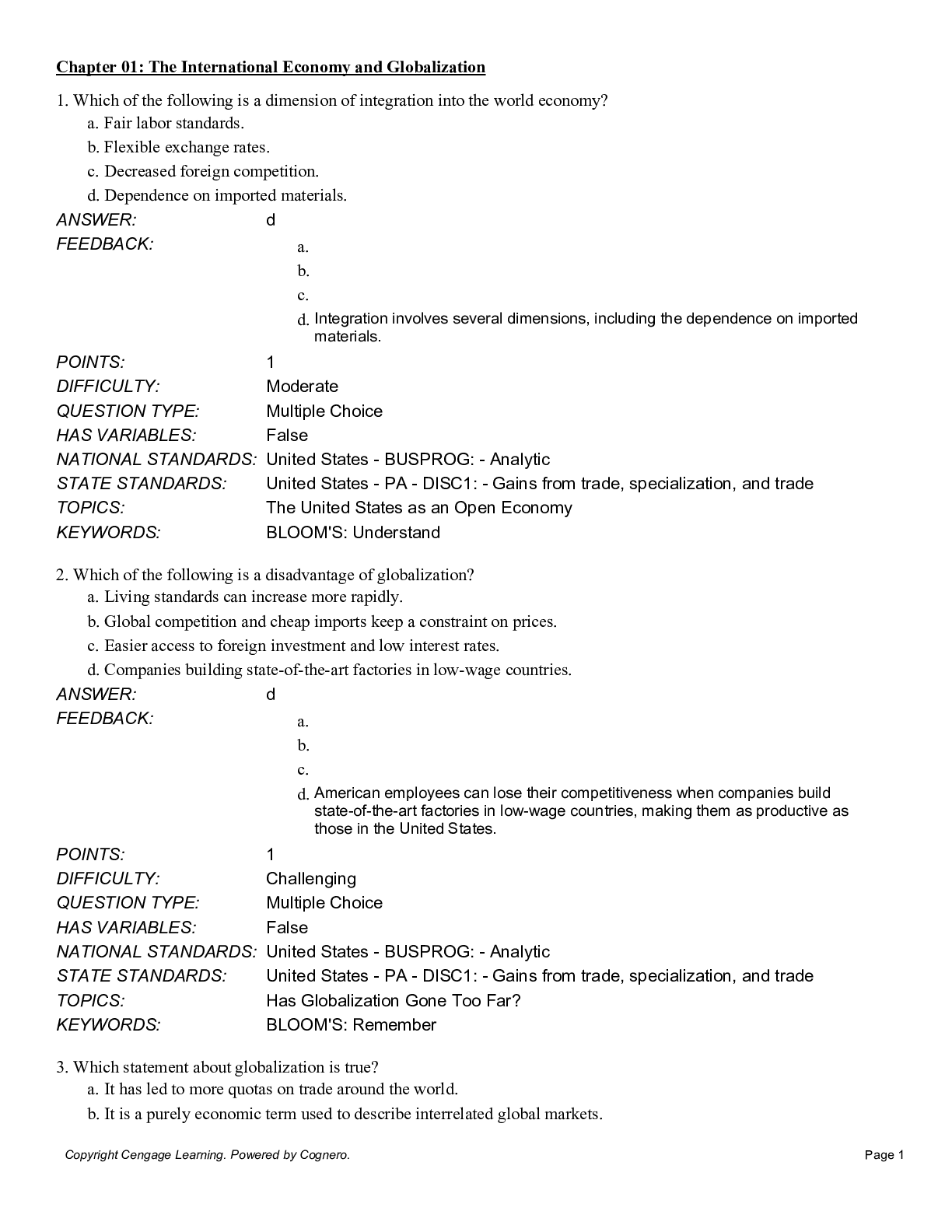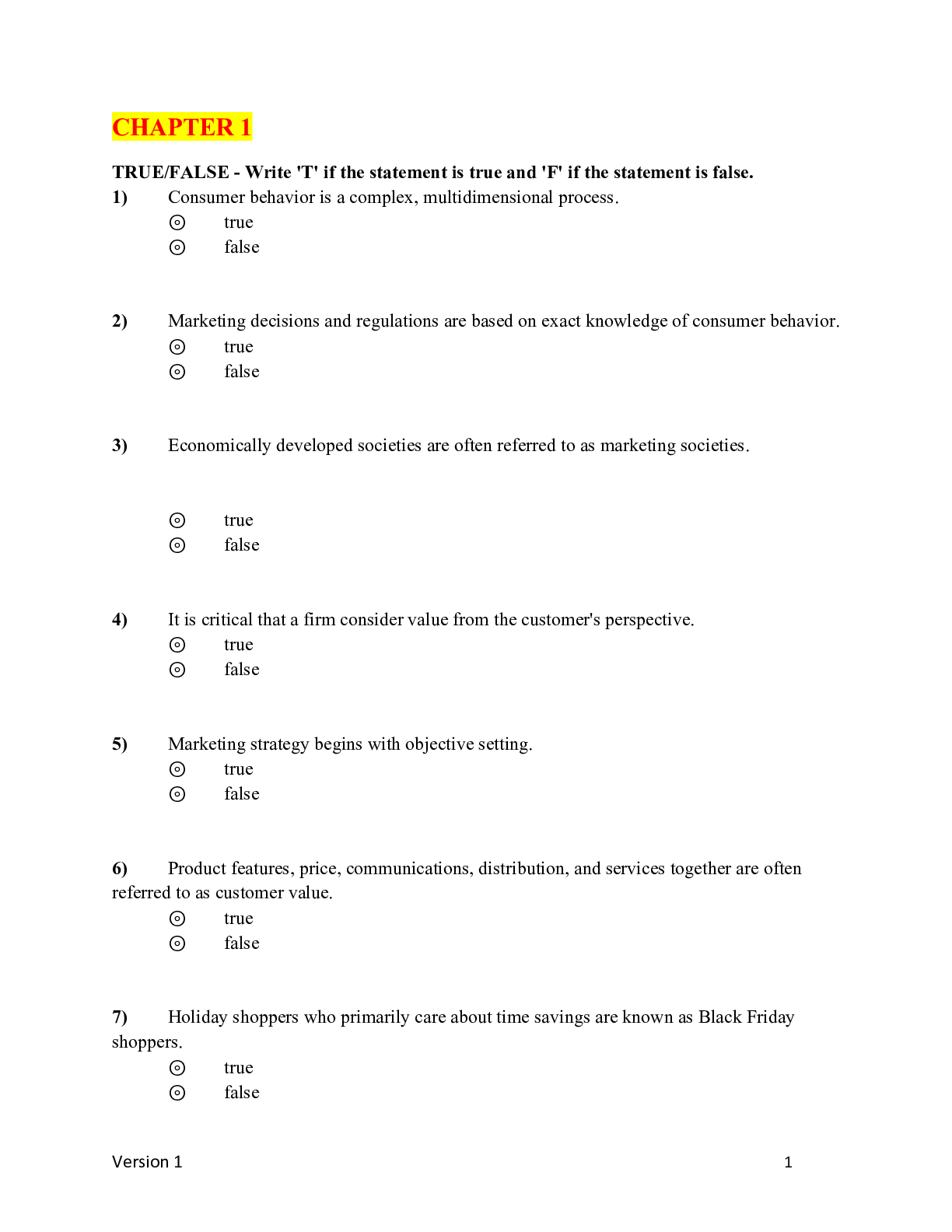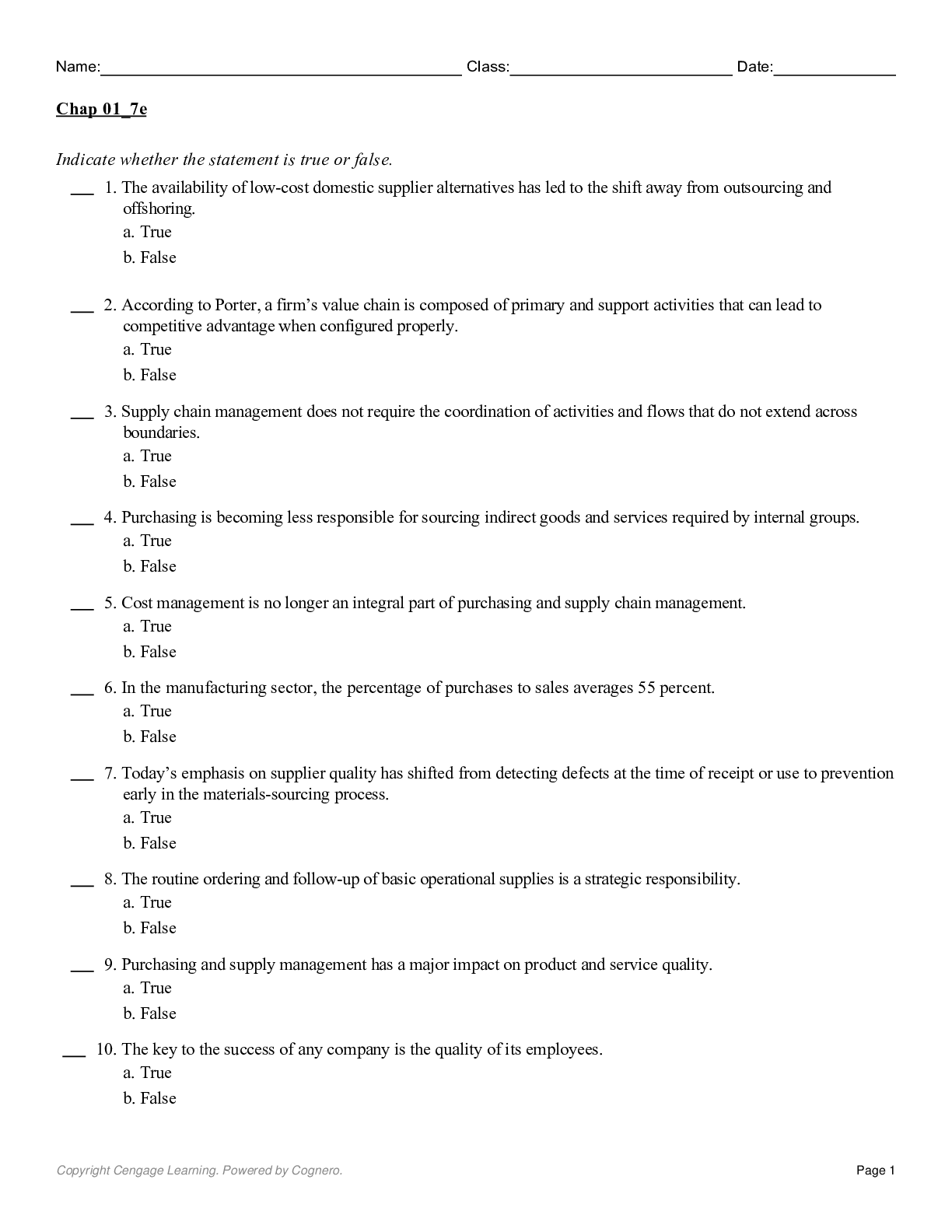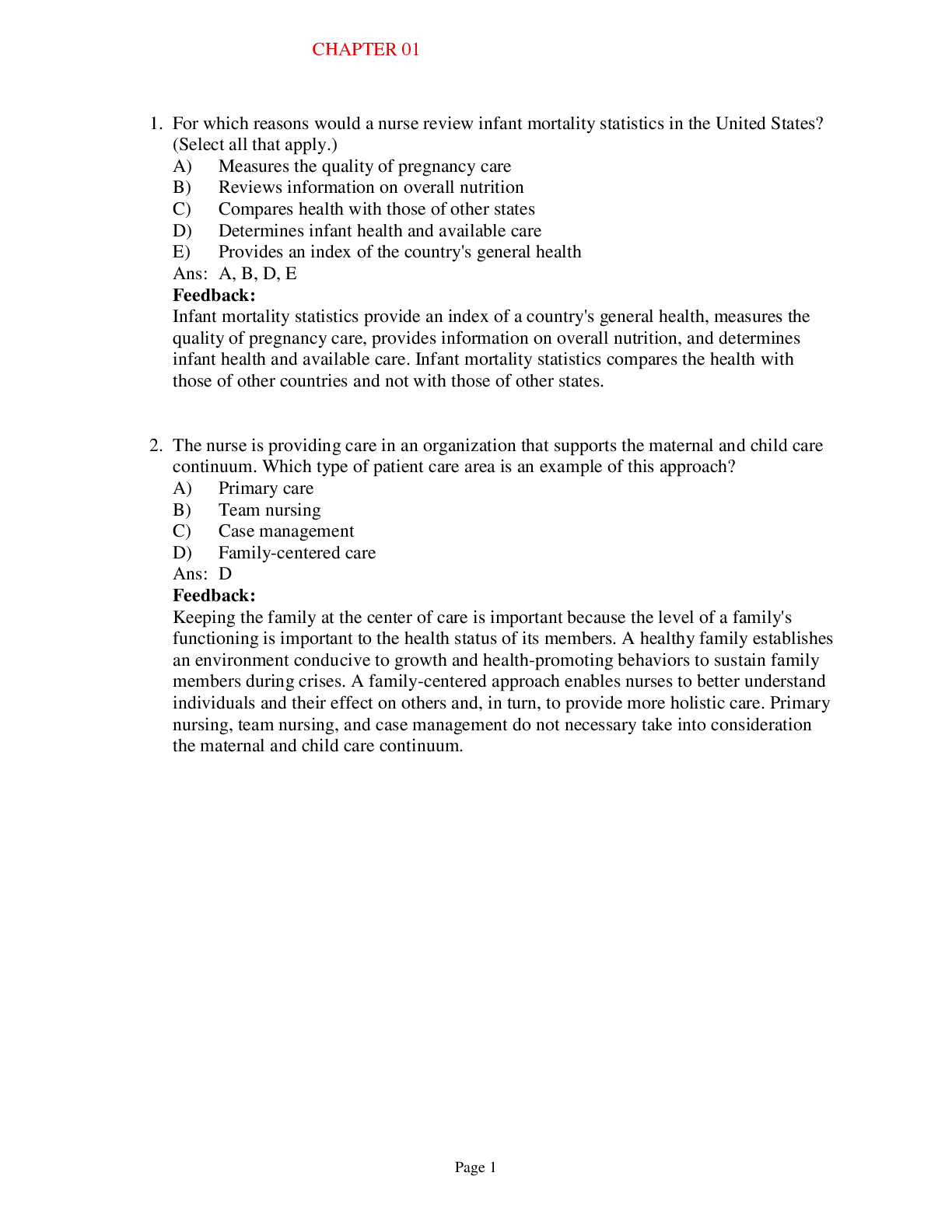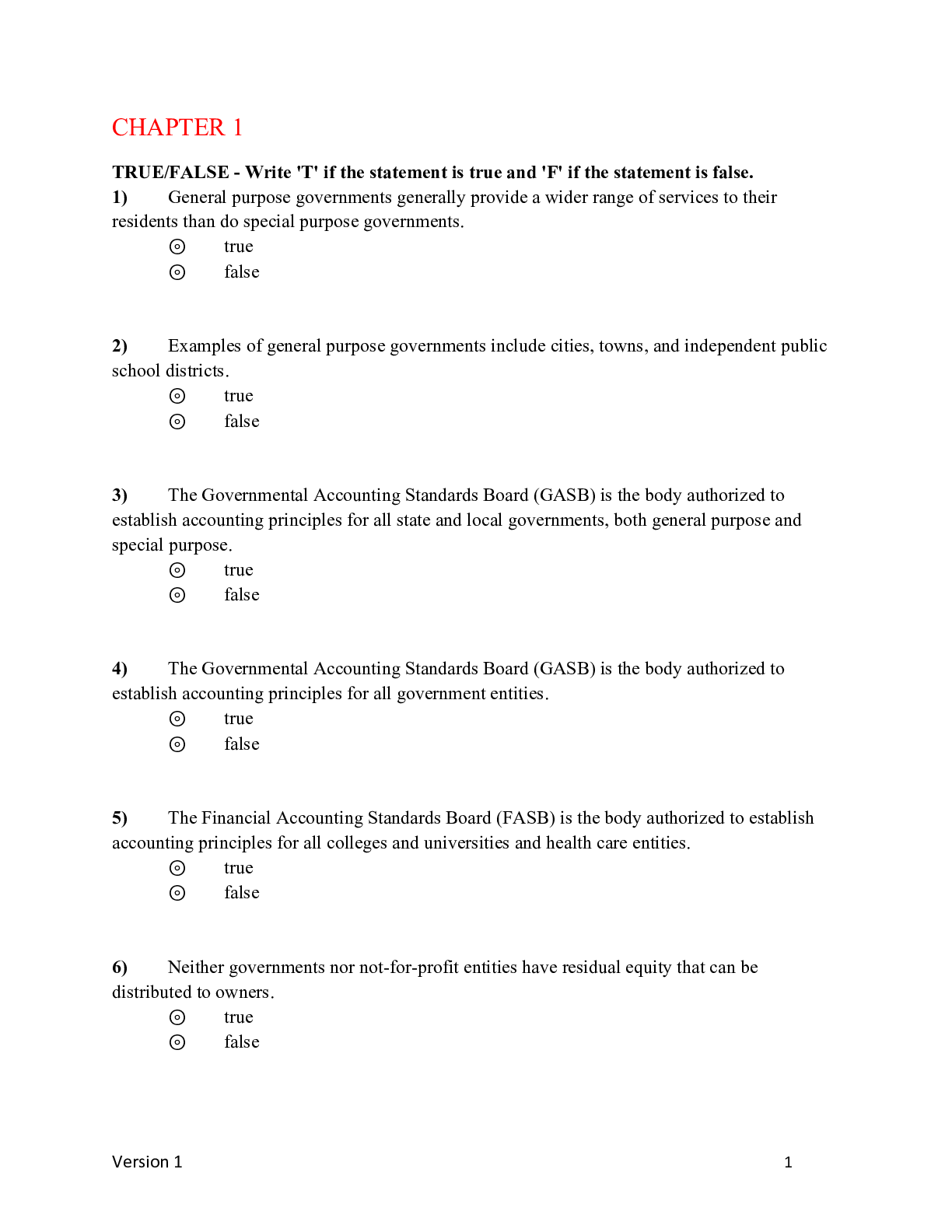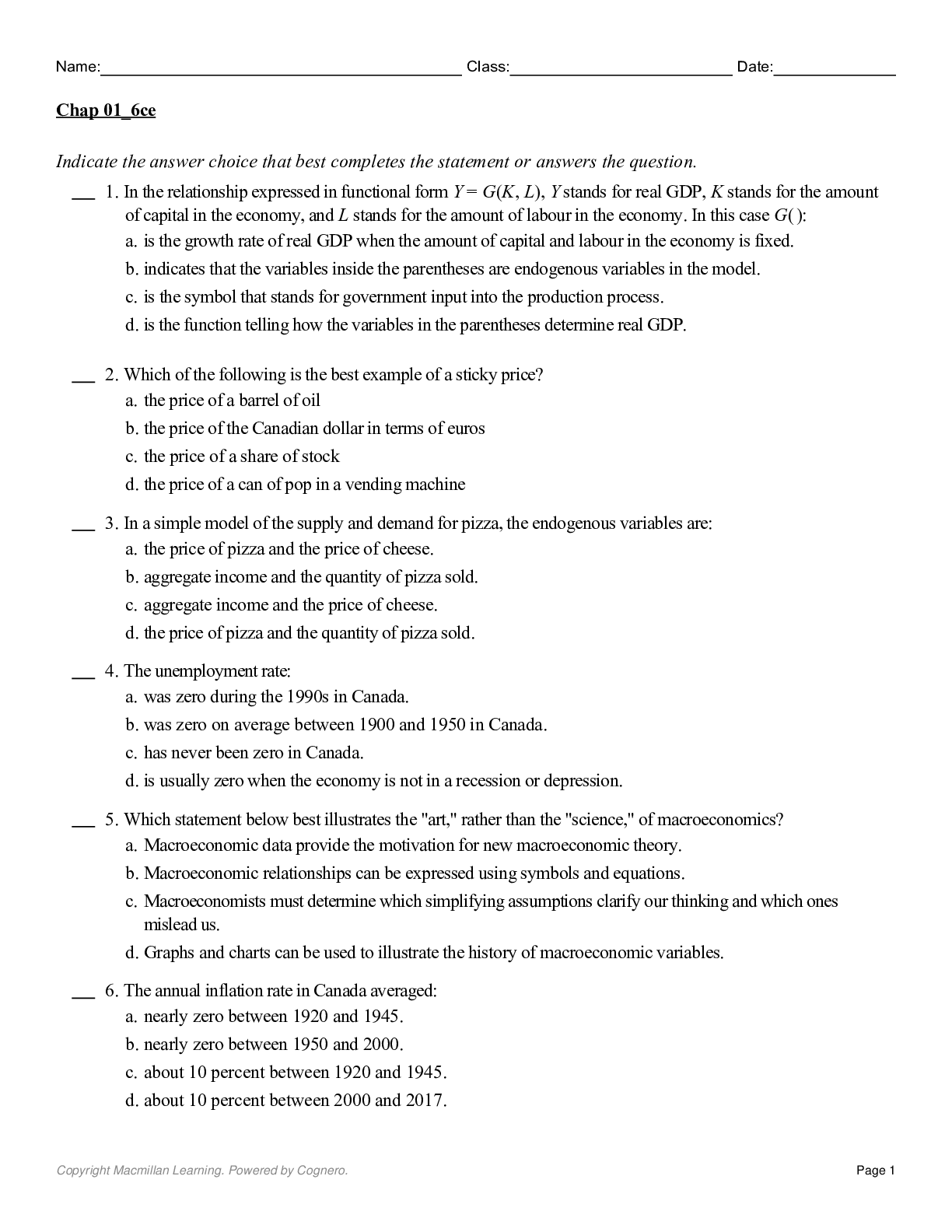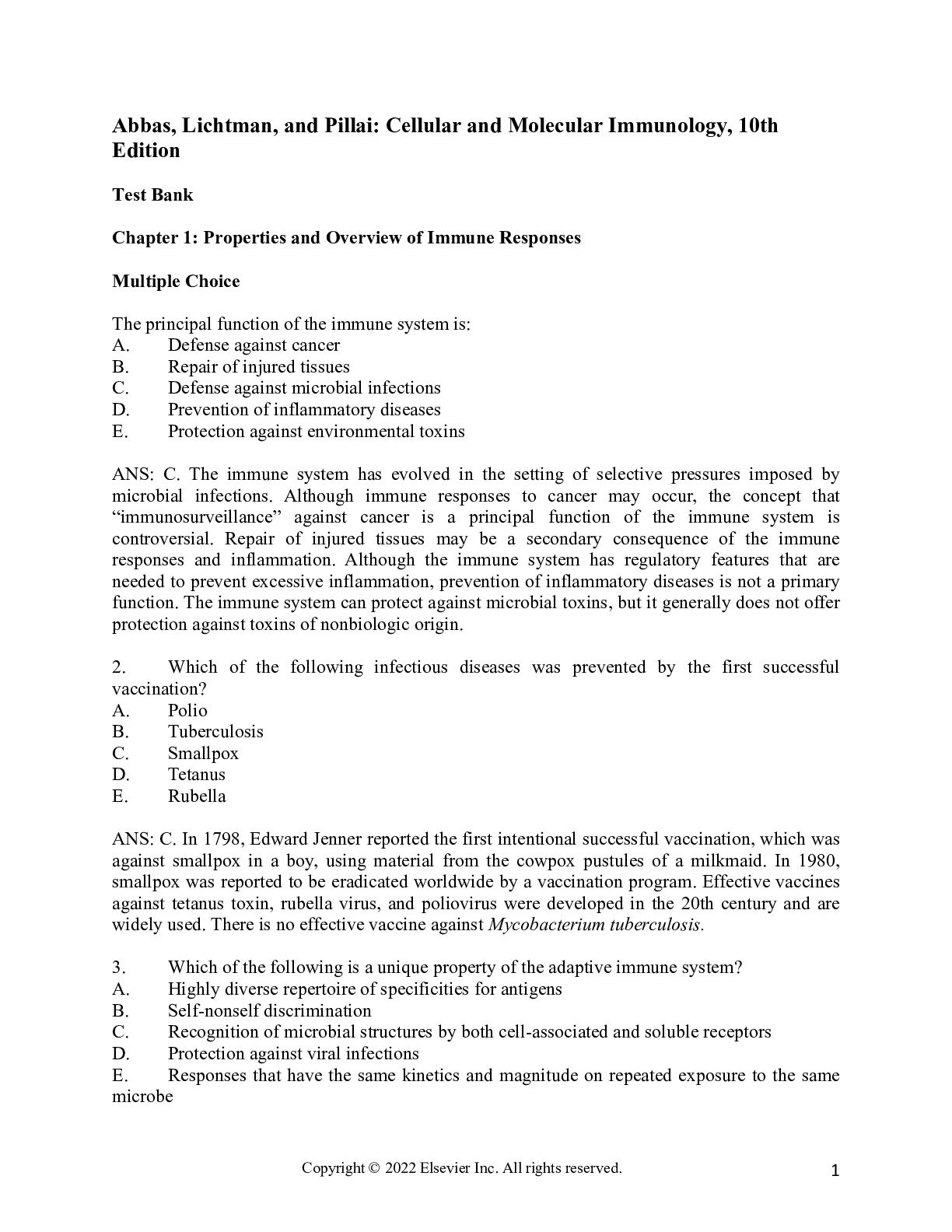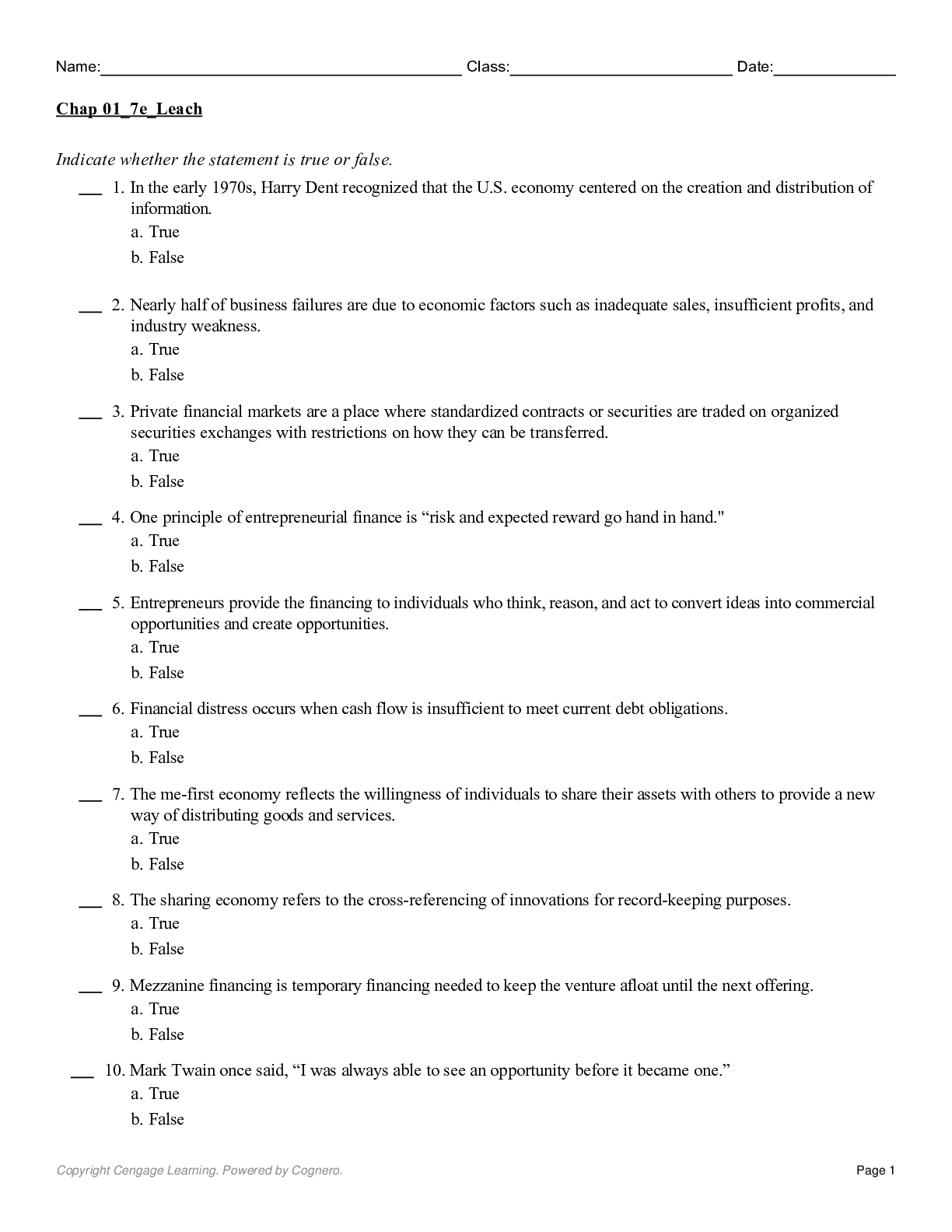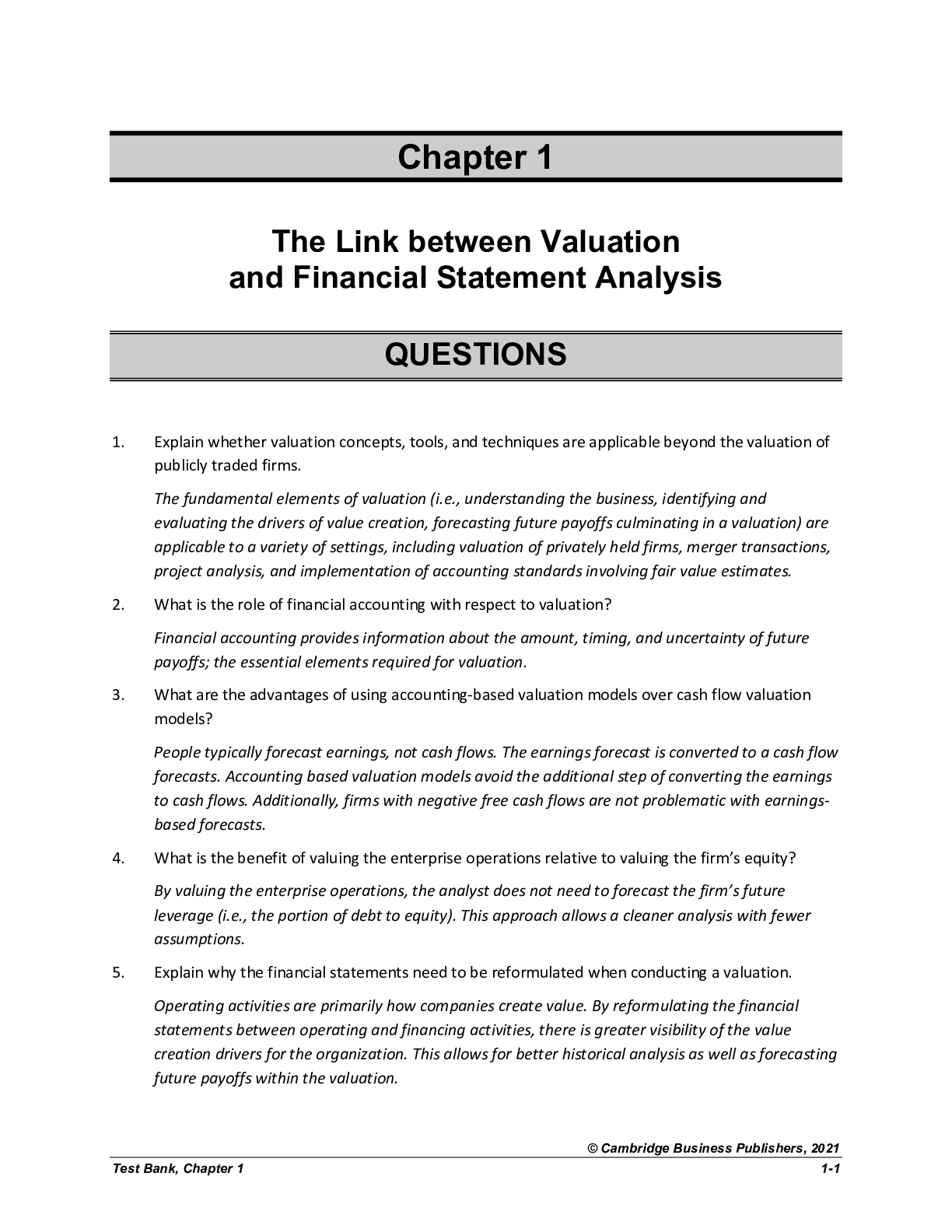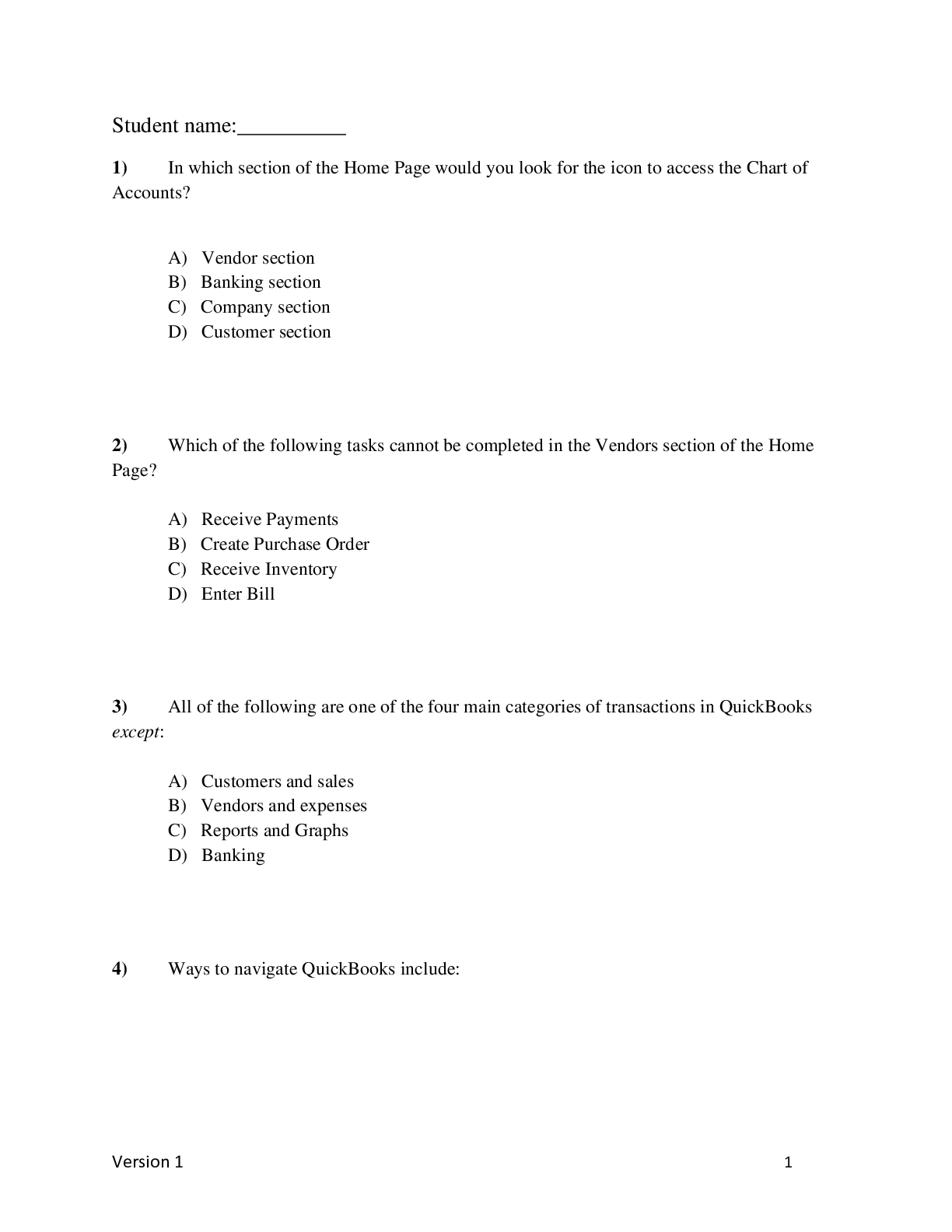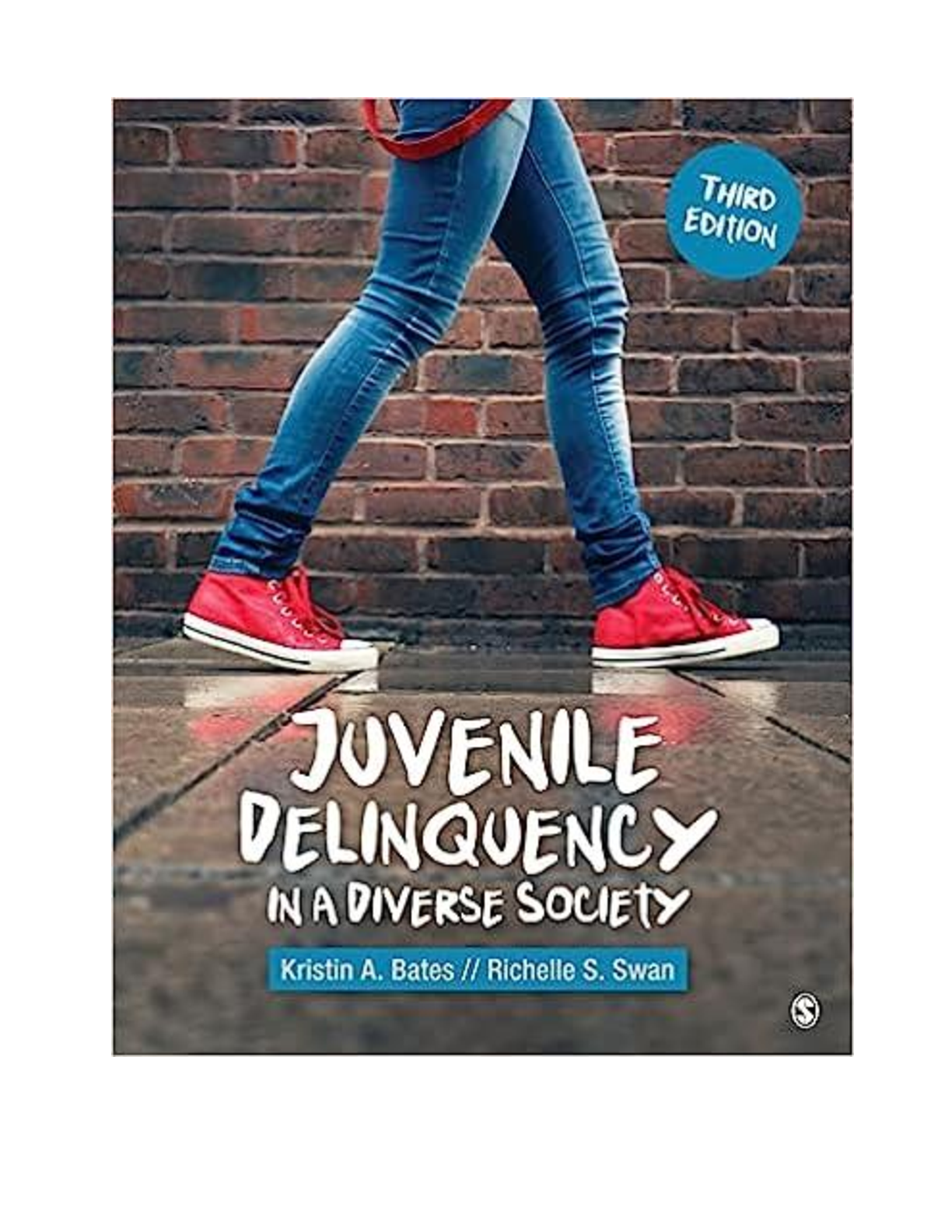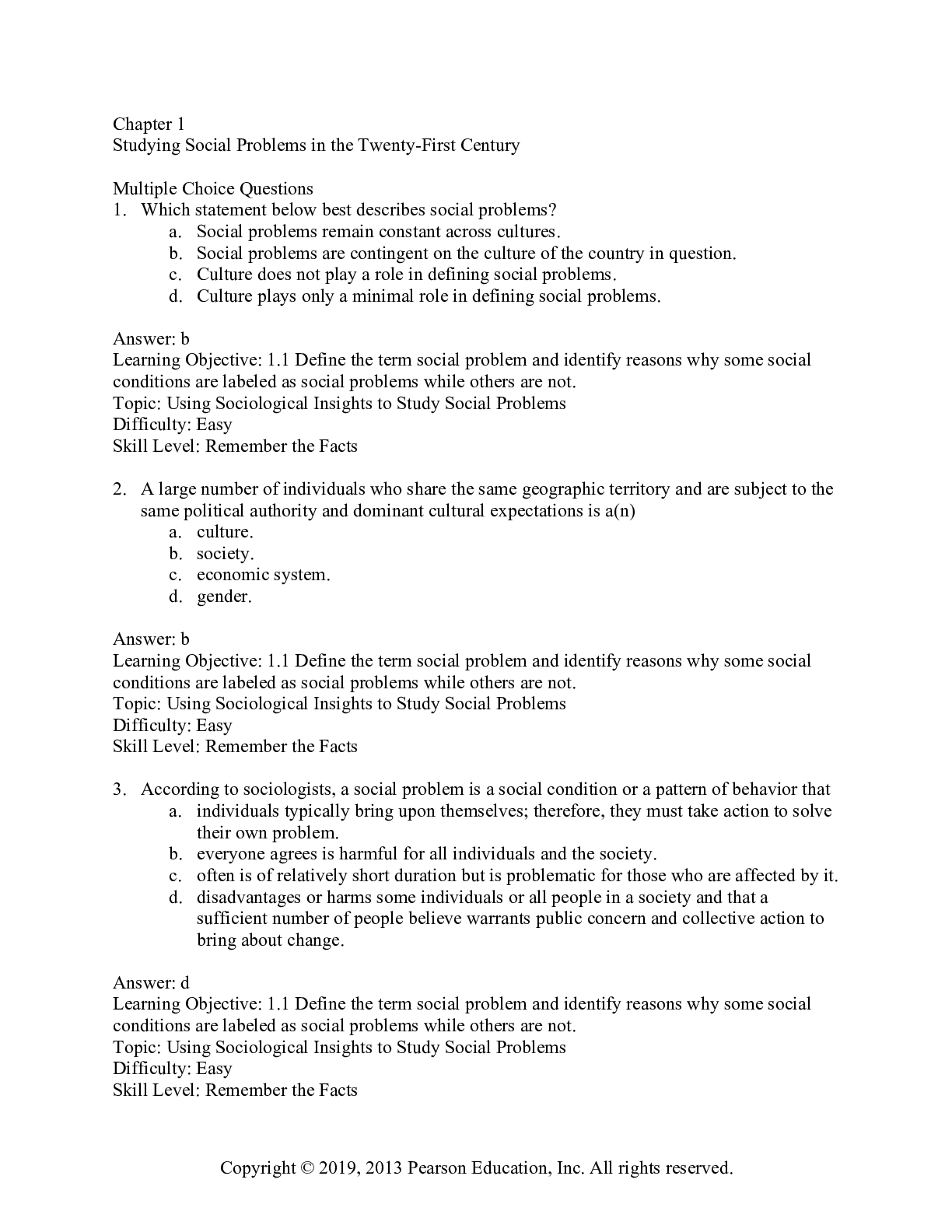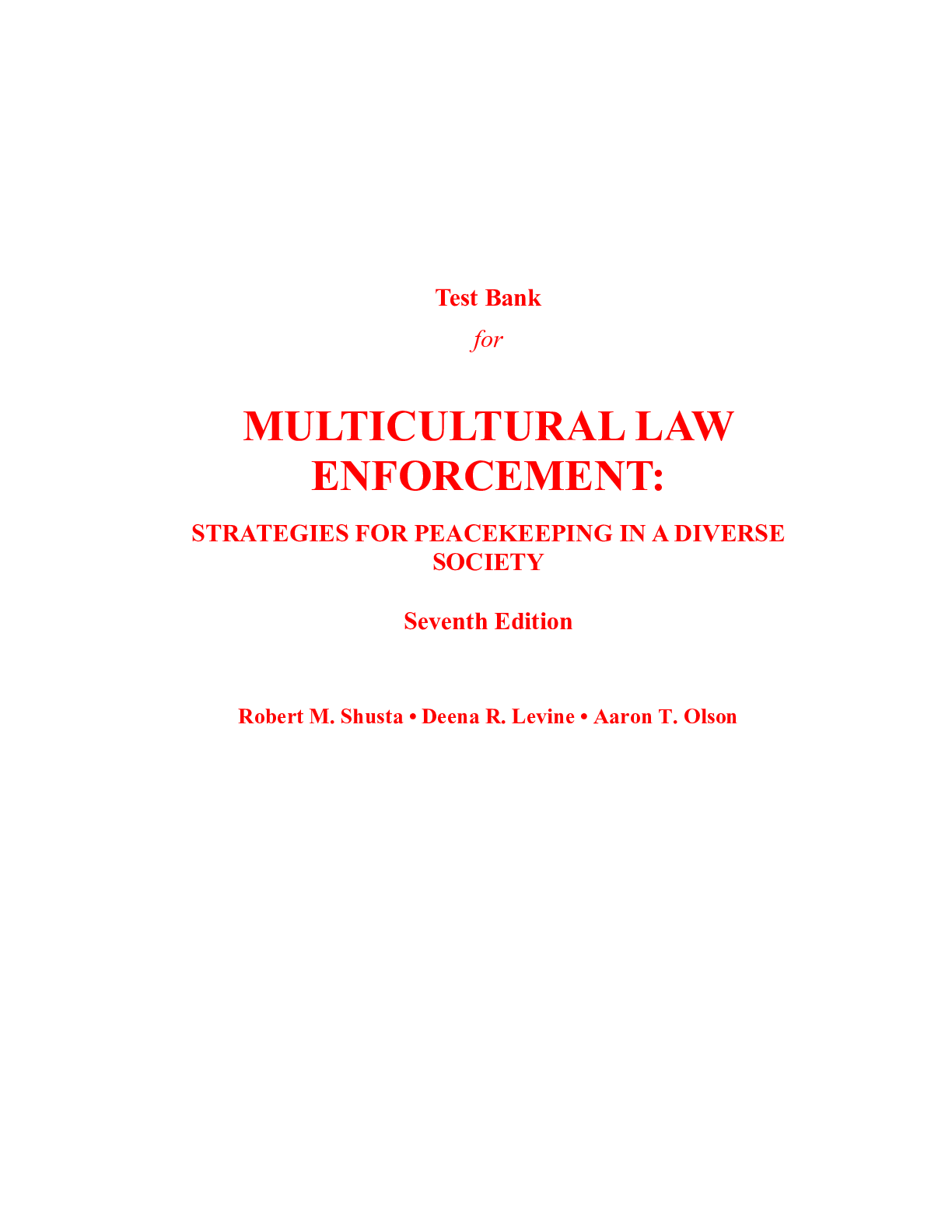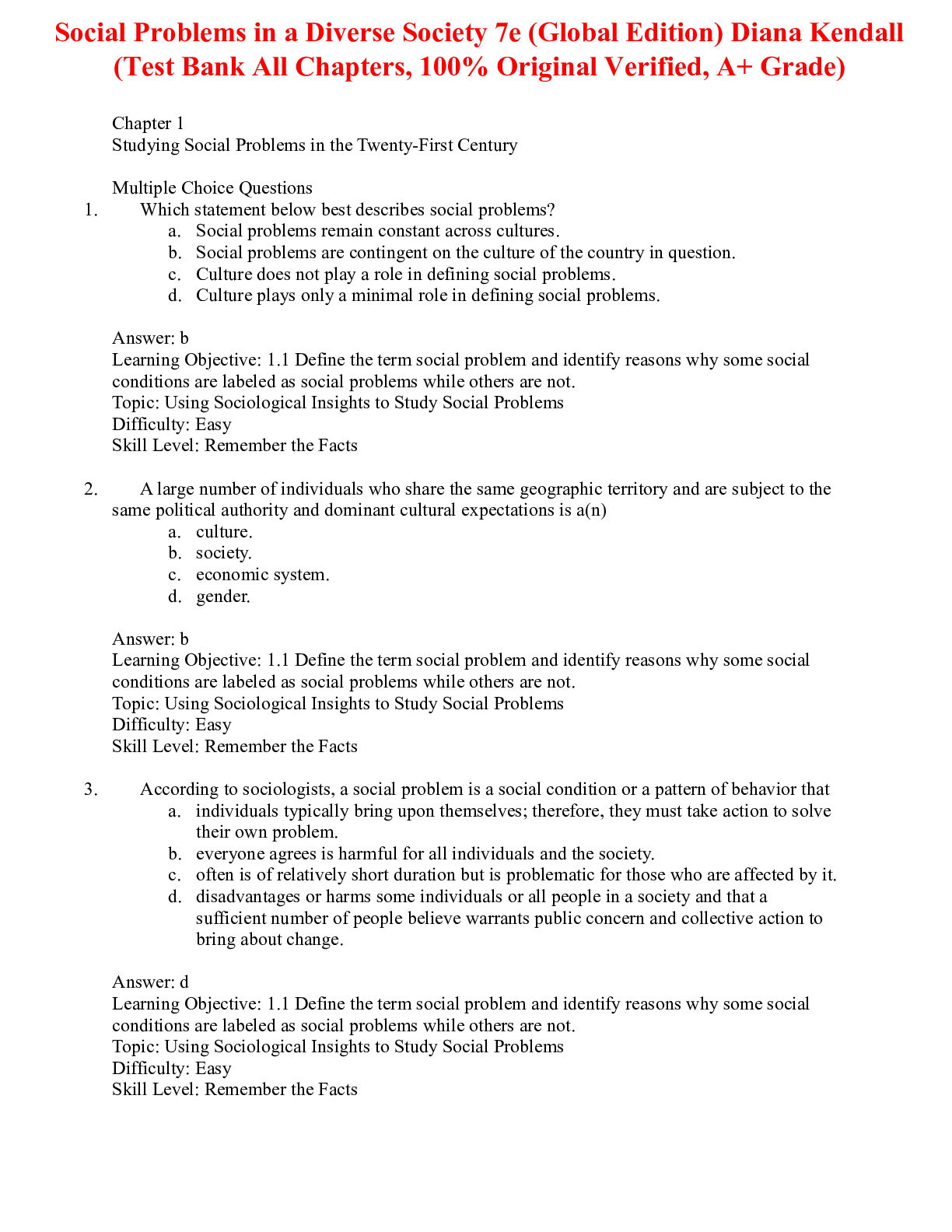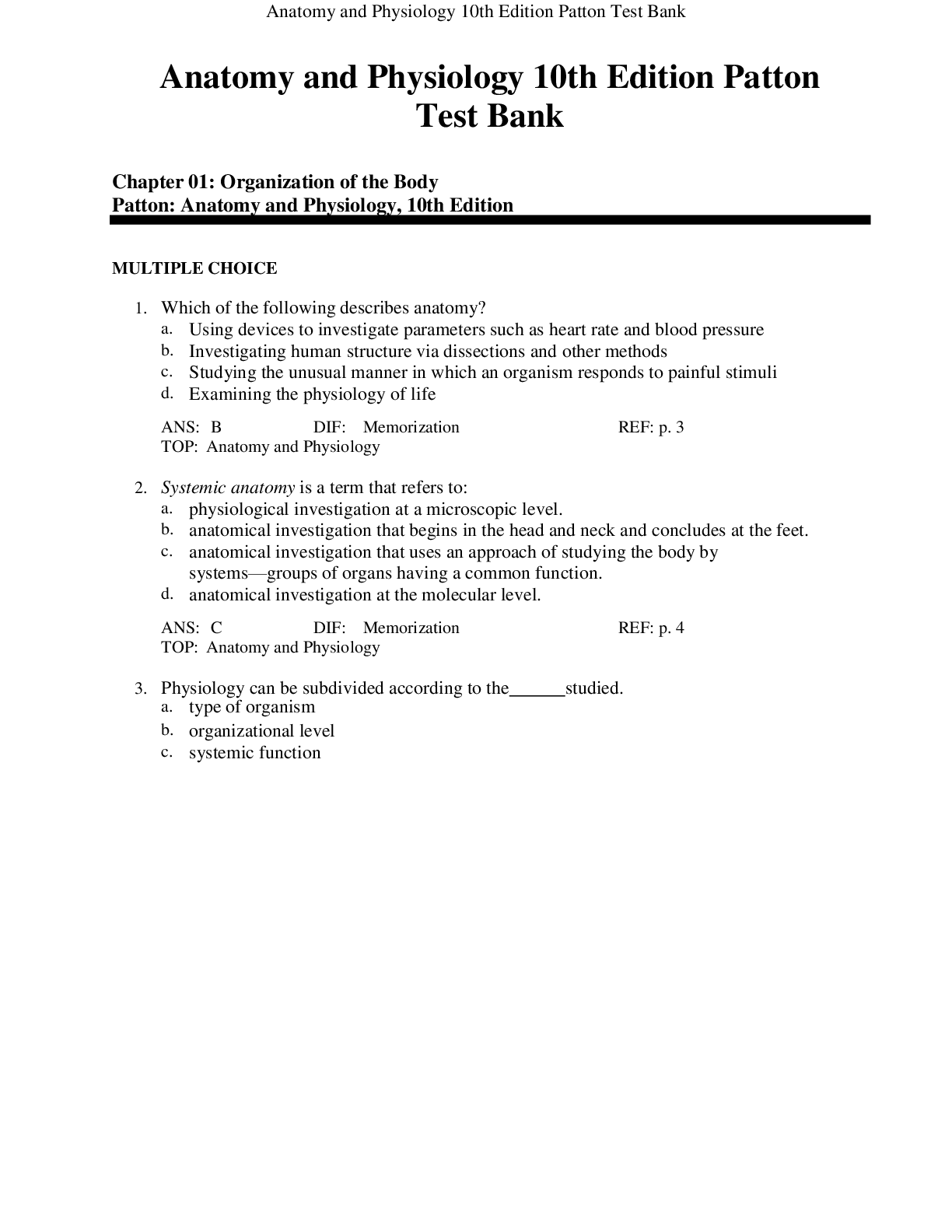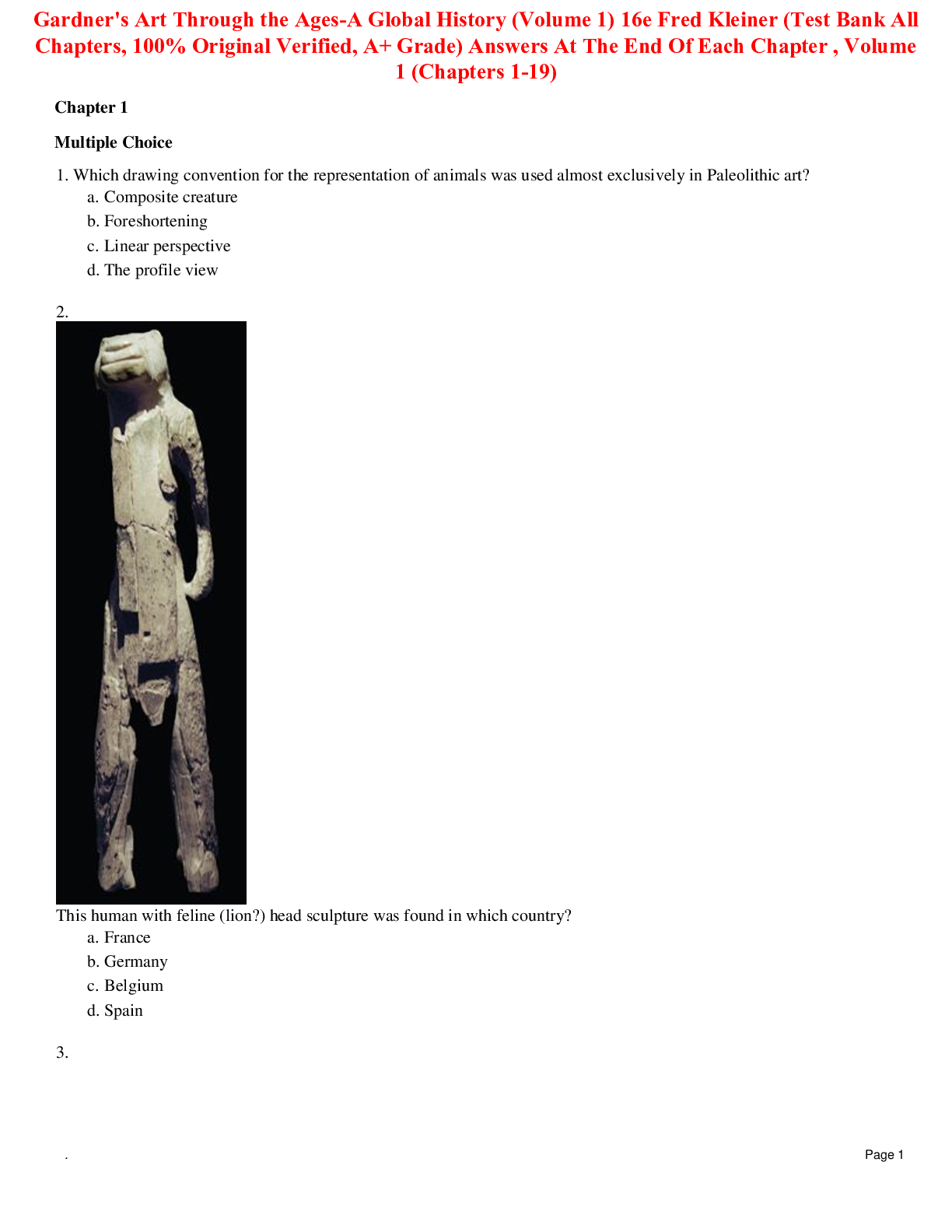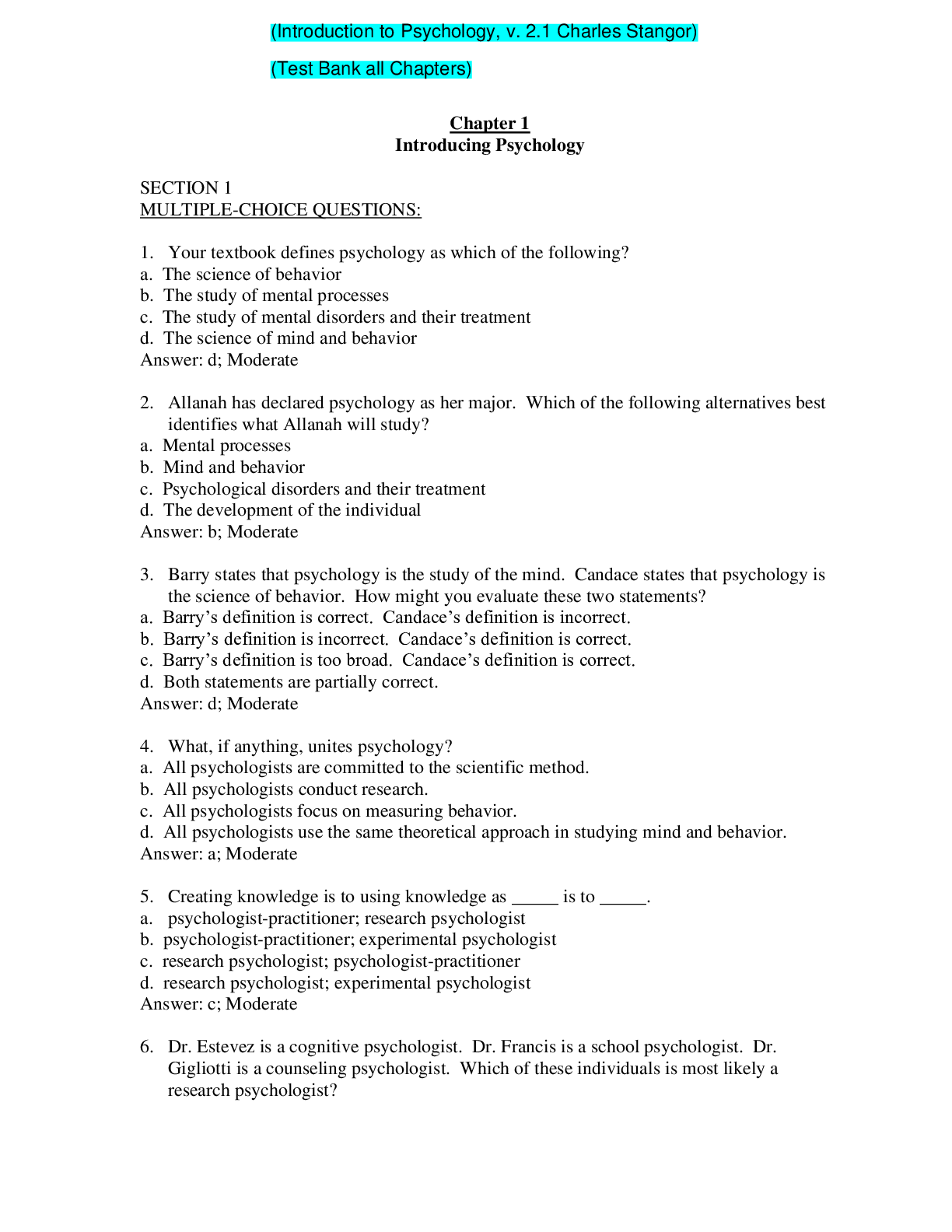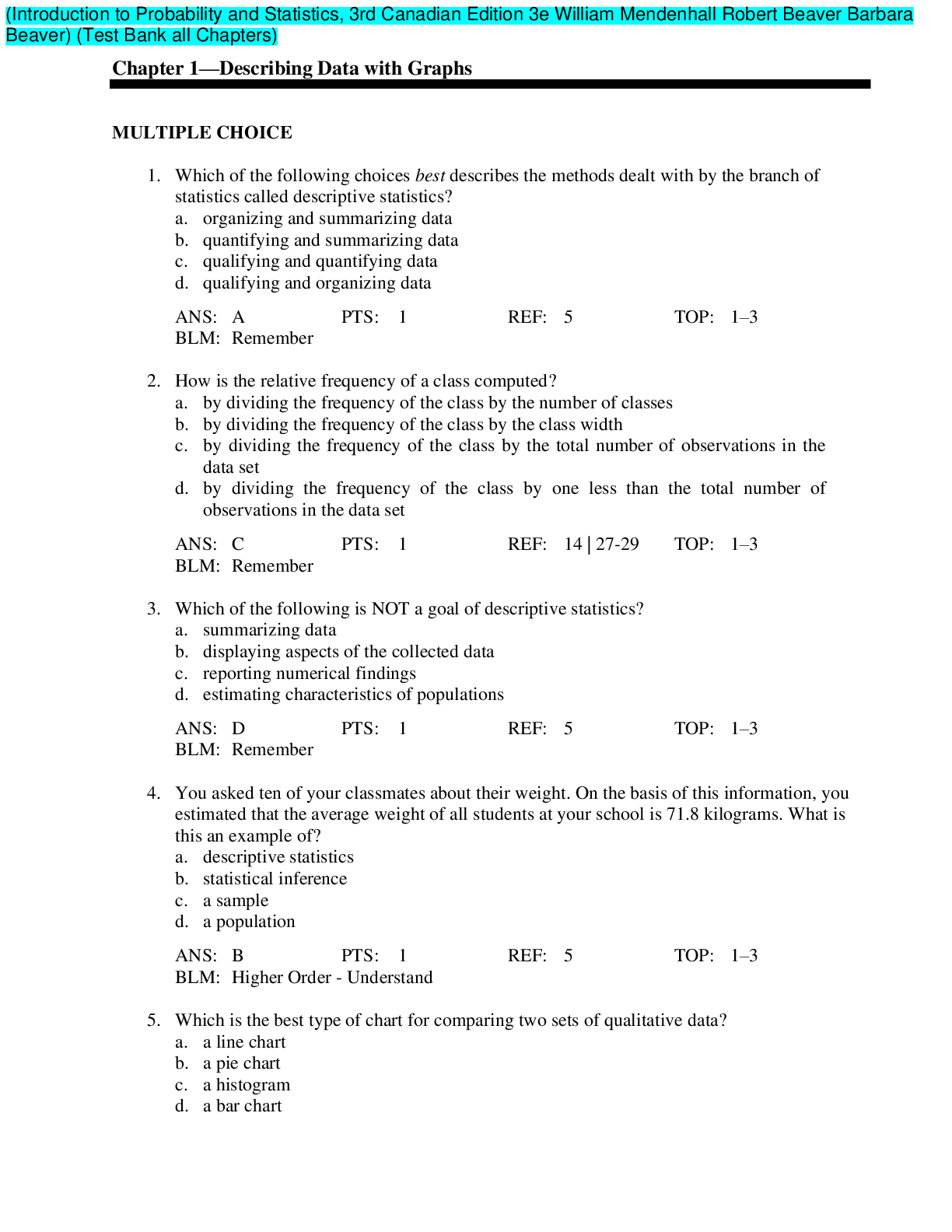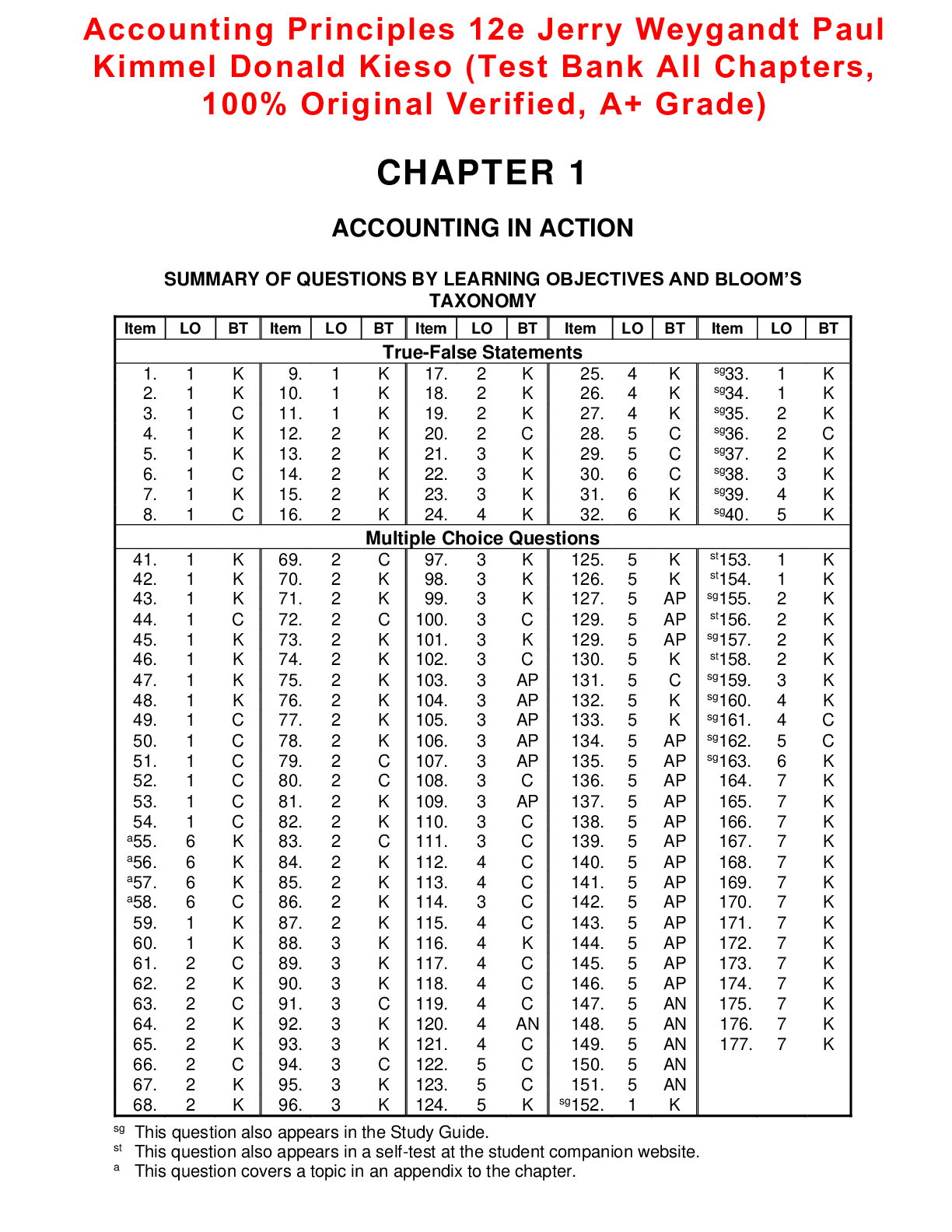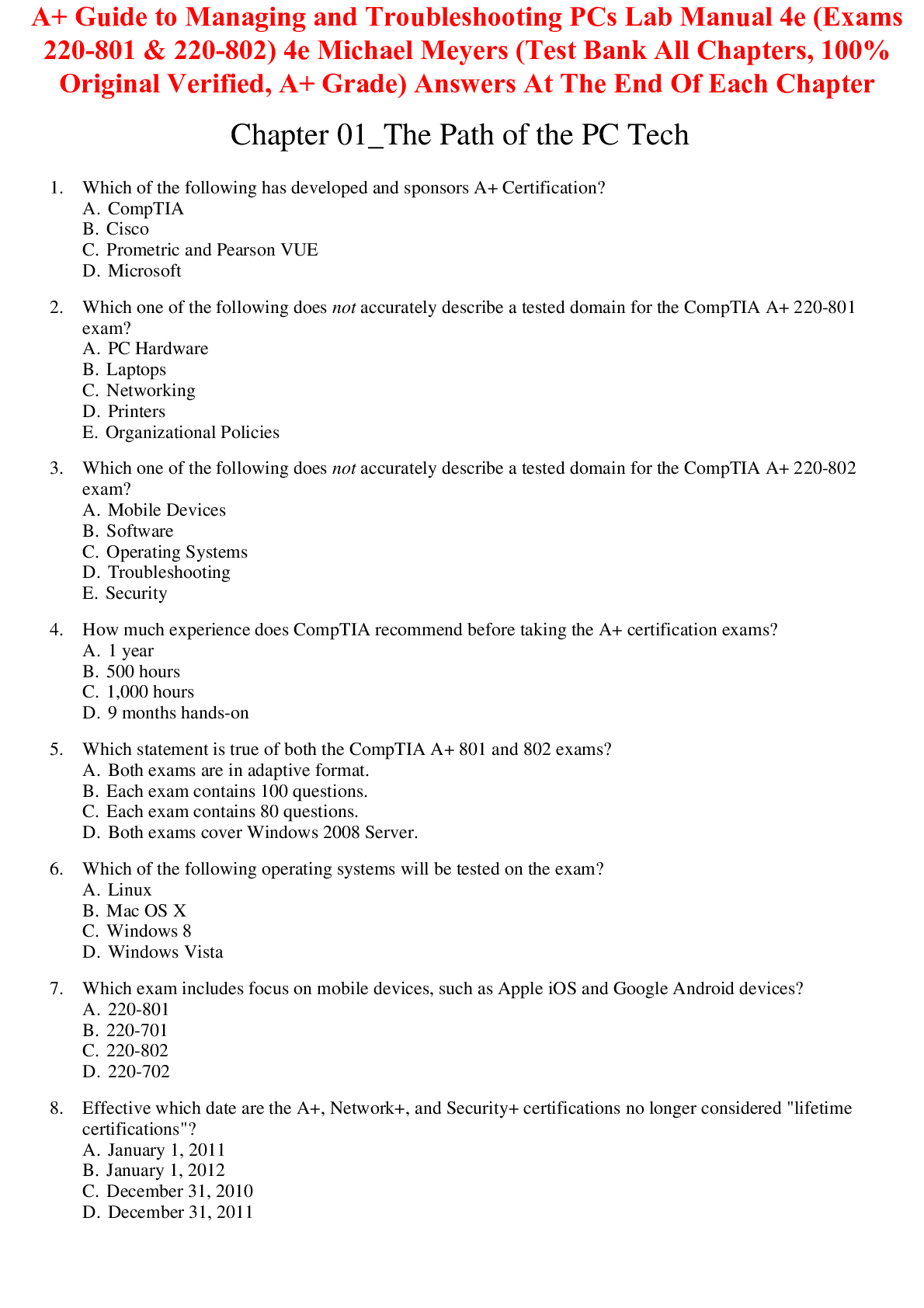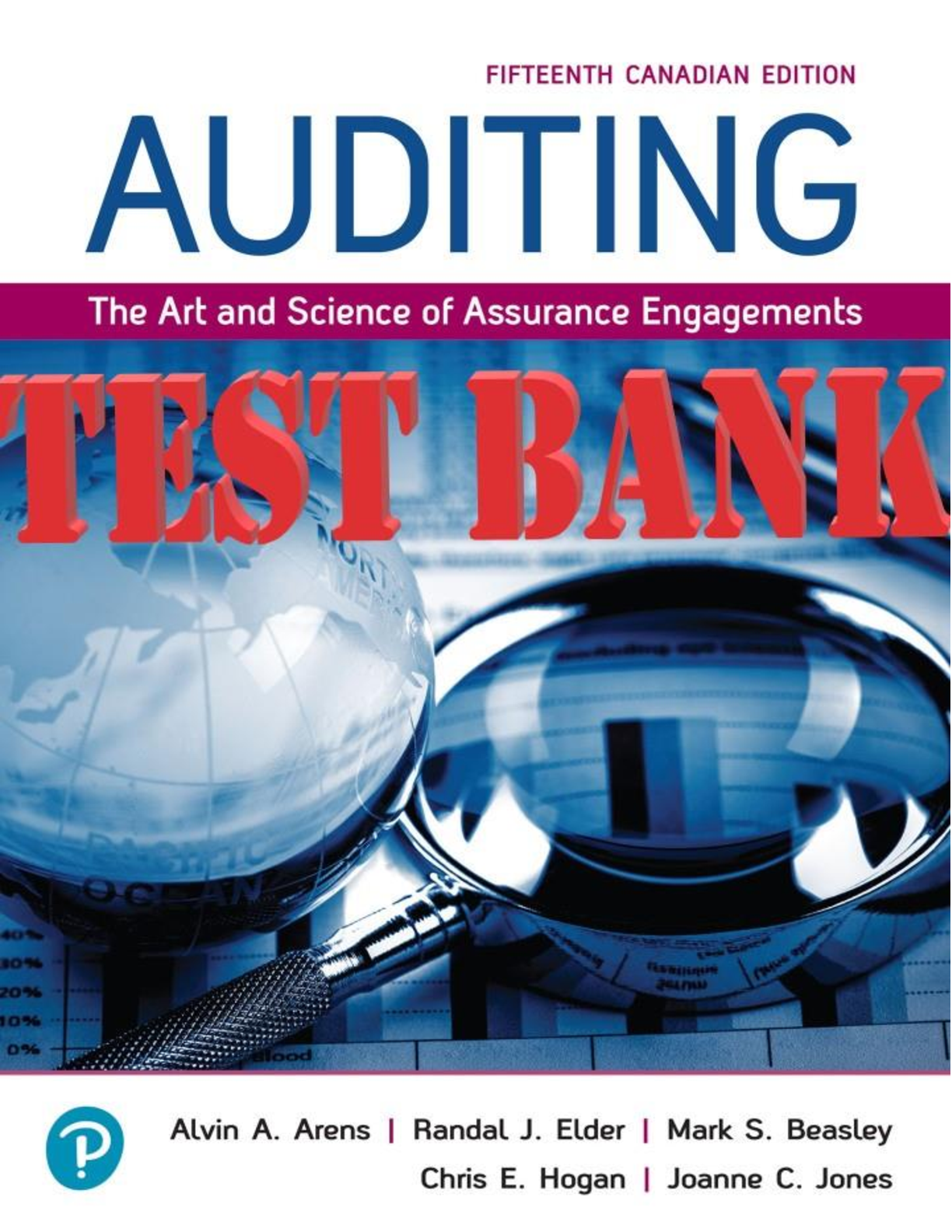Criminology > TEST BANK > Juvenile Delinquency in a Diverse Society, 3rd Edition by Bates TEST BANK (All)
Juvenile Delinquency in a Diverse Society, 3rd Edition by Bates TEST BANK
Document Content and Description Below
Test Bank for Juvenile Delinquency in a Diverse Society, 3rd Edition, 3e by Kristin A. Bates, Richelle S. Swan TEST BANK ISBN-13: 9781544375434 Full chapters included Part 1 • Understanding Juv... enile Delinquency Chapter 1 • Thinking About Juvenile Delinquency in a Diverse Society Chapter Objectives Chapter Pretest Defining Juvenile Delinquency The Special Case of the Juvenile The Definition of Delinquency On the Media: Live Streaming Delinquency and Crime Conceptions of Juvenile Delinquency Normative Conception of Delinquency Social Constructionist Conception of Delinquency Critical Conception of Delinquency The Well-Being of Children A Focus on Research: Samuel Phillips Day’s “Juvenile Crime: Its Cause, Character, and Cure” Economic Circumstances Physical Environment and Safety Education The Cradle-to-Prison Pipeline The United States as a Place Where Race, Class, Gender, and Sexuality Are Important From the Classroom to the Community: Center on Wrongful Convictions of Youth Individual Versus Institutional Racism, Classism, and Sexism In the News: The Income Gap The Intersectionality of Race, Class, and Gender The Sociological Imagination: Five Vignettes Your Sociological Imagination Put to the Test: Five Vignettes Vignette 1: The Problem of Jesse Vignette 2: Theories of Delinquency—Normative, Social Constructionist, and Critical Vignette 3: The Problem of Appropriate Policies Vignette 4: Unequal Enforcement—Class Vignette 5: Unequal Enforcement—Race and Gender The Juvenile Justice System and Diversity Philosophy and Organization of the Book Summary Eye on Diversity Exercise: Social Construction and Media Discussion Questions Key Terms Chapter Pretest Answers Chapter 2 • The Creation of Delinquency Chapter Objectives Chapter Pretest The Social Construction of Youth and Delinquency Ancient Times and the Middle Ages (776 BCE–1400 CE) The Colonial and Revolutionary Period (late 1400s–1800) The “Child-Saving” Era, the Industrial Revolution, and the Creation of the Juvenile Court (1800s–early 1900s) A Focus on Research: Shedding Light on the Black Child Savers: Geoff Ward, Vernetta Young, and Rebecca Reviere Views of Youth and Delinquency in the Juvenile Court (1899–present) Popular Culture: A Target of Moral Panics About Delinquency On the Media: Annual Media for a Just Society Award Winner: Crown Heights In the News: The Panic Over Momo and Children’s YouTube Content At the Crossroads: 21st-Century Social Constructions of Youth and Delinquency From the Classroom to the Community: The Campaign for Youth Justice and Photographer Richard Ross’ “Justice Through a New Lens” Summary Eye on Diversity Exercise: Delinquency and Dependence in 21st-Century Television Shows and Films Discussion Questions Key Terms Chapter Pretest Answers Chapter 3 • Understanding Delinquency: Data, Correlates, and Trends Chapter Objectives Chapter Pretest How to Lie With Statistics What Goes Into a Good Statistic? Sampling The Tyranny of Small Numbers From the Classroom to the Community: The Children’s Defense Fund Qualitative Versus Quantitative Data How Do We Know What We Know? What Data Sources Do We Use to Map Trends? Data Sources for Correlates and Trends in Delinquency Uniform Crime Reports National Incident-Based Reporting System National Crime Victimization Survey On the Media: Podcast: “Improving Youth Programming: The Role of Research” Self-Report Surveys National Longitudinal Survey of Youth In the News: A Tyranny of Small Numbers, or Is YouTube the Start of the Next Australian Girls’ Violence Epidemic? Correlates of Delinquency Age Gender Race and Ethnicity Class A Focus on Research: Ousey and Kubrin’s “Immigration and Crime: Assessing a Contentious Issue” The Nature of Delinquency as Measured by the UCR General Trends in Delinquency Trends Measured by the UCR Self-Report Data: Monitoring the Future Using Gender as an Example: Comparing Trends Across Data Sources Official Trends From the UCR Gender Trends in Illicit Drug Use From Self-Reports Comparisons of Gender and Delinquency Between the UCR, the NCVS, and Self-Report Data: The Girls Study Group Summary Eye on Diversity Exercise: Juvenile Violent Crime Trend in City Discussion Questions Key Terms Chapter Pretest Answers Part 2 • Theories of Juvenile Delinquency Chapter 4 • Micro-Level Theories Chapter Objectives Chapter Pretest Preclassical Ideas Classical Theories Biological, Psychological, and Biosocial Theories Early Biological Theories Psychological Theories On the Media: The Viral Blog Post: I Am Adam Lanza’s Mother Biosocial Theories Differential Association Theory Differential Association Theory and Class, Gender, and Race Class Gender Race Social Control Theory/Social Bonding Theory Classical Social Control Theory Travis Hirschi In the News: The Flint Water Crisis Theory of Self-Control Life Course and Developmental Theories From the Classroom to the Community: Helping Juveniles Make Better Choices: Mujeres Organization Social Control and Gender: The Example of Power-Control Theory Techniques of Neutralization Model General Strain Theory General Strain Theory and Race General Strain Theory and Gender A Focus on Research: Self-Reported Arrests Among Indigenous Adolescents: A Longitudinal Analysis of Community, Family, and Individual Risk Factors Micro-Level Theories and Public Policy Summary Eye on Diversity: Antibullying Exercise: Adding Diversity to the Program Discussion Questions Key Terms Chapter Pretest Answers Chapter 5 • Macro-Level Theories Chapter Objectives Chapter Pretest Social Structural Theories of Delinquency Anomie Theories Durkheim’s Anomie Theory Merton’s Strain Theory Differential Opportunity Theory Subcultural Theory of Delinquency Anomie Theories of Delinquency and Race, Class, and Gender Intersections From the Classroom to the Community: The Boys and Girls Club of America Anomie Theories and Race Anomie Theories and Gender Anomie Theories and Class Social Disorganization Theory Park and Burgess’s Social Disorganization Theory Shaw and McKay’s Social Disorganization and Delinquency Theory Frazier’s Ecological Analysis of Delinquency Among Black Youth Sampson and Groves’s Model of Social Disorganization Collective Efficacy Model Social Disorganization Theories of Delinquency and Race, Class, and Gender Intersections Social Disorganization Theory and Race In the News: Street Outreach With Somali Youth in Minneapolis Social Disorganization Theory and Class Social Disorganization Theory and Gender A Focus on Research: Kubrin and Desmond’s “The Power of Place Revisited: Why Immigrant Communities Have Lower Levels of Adolescent Violence” Social Structural Theories and Public Policy Anomie Social Disorganization On the Media: “On My Block”: Depicting Teen Life in South Los Angeles Summary Eye on Diversity Exercise: A Look at Sexuality, Homeless Youth, and Delinquency Discussion Questions Key Terms Chapter Pretest Answers Chapter 6 • Critical Theories Chapter Objectives Chapter Pretest Critical Theories of Delinquency Labeling Theory Origins of Labeling Theory On the Media: National Public Radio’s Caught: The Lives of Juvenile Justice Podcast Development of Labeling Theory Labeling, Self-Concept, and Gender Labeling, Social Exclusion, Race, and Class What About Positive Labeling? Resistance to the Delinquent Label A Focus on Research: Dennis’s “Nothing Out There: Community Awareness and Delinquency of Among Gay and Lesbian Youth Conflict Theory: A Focus on Socioeconomic Class The Origins of Conflict Theory The Development of Conflict Theories of Crime Conflict Theories of Delinquency In the News: Adnan Syed’s Appeal Denied Feminist Theories: A Focus on Gender and Intersectionality The Origins of Feminist Theories The Development of Feminist Theories of Crime and Delinquency From the Classroom to the Community: Girls Flex: True Strength Comes From Within Critical Theories of Delinquency and Public Policy Summary Eye on Diversity Exercise: Are Critical Theories of Delinquency Being Put Into Action in Your Area? Discussion Questions Key Terms Chapter Pretest Answers Part 3 • The Social Contexts of Juvenile Delinquency Chapter 7 • Families in Context Chapter Objectives Chapter Pretest Family Today Trends in the Family—Marriage, Divorce, and Unmarried Birth Rates Trends in Family Structure/Composition On the Media: Podcasts, Parenting, and the LGBTQ Community Family and Delinquency Family Structure and Delinquency What Exactly Is Family Structure? Family Process and Delinquency Attachment From the Classroom to the Community: Parent Responsibility Laws: Should the Parent Be Held Responsible for Youth Behavior? Supervision Conflict Discipline Diversity and the Family Gender, Family, and Delinquency Intersections of Gender, Class, Family, and Delinquency In the News: Law Bans Parents’ Testimony Against Their Children Intersections of Race, Gender, Class, Family, and Delinquency Child Maltreatment Child Maltreatment and Delinquency Girls, Abuse, Running Away, and Delinquency A Focus on Research: Rosario, Schrimshaw, and Hunter’s Homelessness Among Lesbian, Gay, and Bisexual Youth Parents in Prison The Impact of an Incarcerated Parent Foster Care and Foster Youth Summary Eye on Diversity Exercise: Parenting in Prison Discussion Questions Key Terms Chapter Pretest Answers Chapter 8 • Schools in Context Chapter Objectives Chapter Pretest The Diverse School Experience Trends in Academic Achievement Math Reading International Comparisons The Budgeting of Education School Failure, Dropping Out, and Delinquency School Failure Tracking Alienation Social Class The Effect on Delinquency Dropping Out The Effect on Delinquency Disengagement and Delinquency Crime and Delinquency in Schools Violence at School In the News: Parents May Face Arrest for Student Absences Bullying and Cyberbullying A Focus on Research: Leavy and Maloney’s American Reporting of School Violence and “People Like Us”: A Comparison of Newspaper Coverage of the Columbine and Red Lake School Shootings Bullying Homophobic Bullying and Sexual Harassment: Two Specific Types of Bullying Cyberbullying On the Media: Social Media and Bullying The Policy of Punishment in Schools: The School-to-Prison Pipeline School-to-Prison Pipeline: Zero Tolerance and Increased Social Control School-to-Prison Pipeline: Learning to Accept Corporal Punishment, Restraint, and Seclusion The School and Student Rights From the Classroom to the Community: Marjory Stoneman Douglas High School Students and the #NeverAgain Campaign Summary Eye on Diversity Exercise: Examining School Data on Delinquency Discussion Questions Key Terms Chapter Pretest Answers Chapter 9 • Peers and Gangs in Context Chapter Objectives Chapter Pretest Why Do Peers Matter to Delinquency? Friendship and Delinquency: How Gender Matters The Kid in the Corner: The Impact of a Lack of Friendships A Focus on Research: Unnever, Cullen, and Barnes’s “Racial Discrimination and Pathways to Delinquency” Conventional Adolescence or New Forms of Delinquency? The Use of Technology as a Means of Peer Interaction Sexting In the News: Court Labels Girl’s Graphic Text to Friends as Child Pornography Documenting Delinquency Online Gangs and Delinquency What Is a Youth Gang? How Common Is Youth Gang Activity? What Ethnic and Racial Groups Have Been Represented in Youth Gang Formation in the United States? Why Do Youth Gangs Form, and Why Does Gang Violence Occur? A Focus on Social Class, Race, Sexuality, and Social Inequality Gender, Sexuality, and Gangs Responses to Youth Gangs Civil Gang Injunctions: A Suppression Method Facing Sociolegal Challenges On the Media: Use of Social Media Pictures in Gang Allegations Against Immigrant Youth From the Classroom to the Community: College Bound Dorchester and Boston Uncornered: Recruiting Gang-Involved Youth to College Summary Eye on Diversity Exercise: Gangs and Technology Discussion Questions Key Terms Chapter Pretest Answers Chapter 10 • Drugs in Context Chapter Objectives Chapter Pretest Reasons for and Societal Understandings of Drug Use The Role of Legal Products in Youth Substance Use Youth Substance Use Patterns Today Gender, Race, Ethnicity, and General Drug Use Patterns A Focus on Research: Subica and Wu’s Substance Use and Suicide in Pacific Islander, American Indian, and Multicultural Youth Rates of Serious or Risky Youth Substance Use The Repercussions of Serious Substance Use On the Media: Tribal Justice: Documenting Alternative Courts for Indigenous Youth The Relationship of Substance Use to Delinquency Gender, Race, Ethnicity, and Sexuality Factors Responses to and Prevention of Youth Drug Use Media Campaigns Drug Abuse Resistance Education (D.A.R.E.) Drug Testing Drug Courts Drug Rehabilitation Programs In the News: Purdue Pharma, Producer of OxyContin, Faces Lawsuits in Almost Every US State Differing Policy Approaches: Drug Prohibition, Legalization, and Harm Reduction Strategies From the Classroom to the Community: The Amend the RAVE Act Campaign Cultural Issues and Drug Prevention and Rehabilitation Programs Project Venture: An American Indian and Alaska Native Youth-Oriented Program Amish Youth Vision Project: A Drug and Alcohol Intervention Program Aimed at Amish Teens Summary Eye on Diversity Exercise: Finding Culturally Relevant Drug Prevention/Treatment Programs Discussion Questions Key Terms Chapter Pretest Answers Part 4 • Responses to Juvenile Delinquency Chapter 11 • Why a Separate Juvenile Justice System? Chapter Objectives Chapter Pretest What Is the Goal of the Juvenile Justice System? Justifications for Punishment From the Classroom to the Community: The National Juvenile Defender Center Juvenile Justice and Specialized Terminology Philosophical Shifts and the Legal Treatment of Juveniles The Due Process Revolution The “Get Tough” Period: An Emphasis on Retribution, Incapacitation, and Deterrence The Federal Response to the “Get Tough” Trend: The Juvenile Justice and Delinquency Prevention Act Turning Tides? The 2000s and the Reassertion of Youth Differences In the News: Supreme Court to Consider the Sentencing of Minors in DC Sniper Case On the Media: Time: The Kalief Browder Story The Future of Juvenile Justice A Focus on Research: Dobbs’s Beautiful Brains: Scientific Discoveries About Adolescent Brain Development Summary Eye on Diversity Exercise: The Treatment of Juvenile Delinquency in South Korea and Around the World Discussion Questions Key Terms Chapter Pretest Answers Chapter 12 • Policing and Juveniles Chapter Objectives Chapter Pretest Police and Juveniles Roles of the Police Police–Juvenile Contact Police Interactions With Juveniles From the Classroom to the Community: Strategies For Youth: Connecting Cops & Kids When Is a Juvenile in Custody? The Cases of Yarborough v. Alvarado (2004) and J. D. B. v. North Carolina (2011) Policing and Discretion Police Use of Force In the News: The Deaths of Trayvon Martin, Michael Brown, and Tamir Rice Policing and Unequal Treatment by Race, Class, Gender, and/or Sexuality A Focus on Research: McCandless’s Study of LGBT Homeless Youth and Policing Programs to Improve Police–Youth Relations On the Media: The Use of the Documentary 3½ Minutes, 10 Bullets to Train Police Officers Summary Eye on Diversity Exercise: Examining the Policing of Youth With Intellectual and Developmental Challenges Discussion Questions Key Terms Chapter Pretest Answers Chapter 13 • The Process of the Juvenile Court Chapter Objectives Chapter Pretest An Overview of the Juvenile Justice Process Jurisdiction: Transfer to the Criminal Court or Remain in the Juvenile Court? Diversion In the News: Charging Juveniles as Adults Not Unusual: Law Requires Prosecutors to Charge Many Teens as Adults for Specific Set of Crimes Preadjudication Stage The Intake Process Detention Intake and Detention Hearing Plea Bargaining Adjudication Stage From the Classroom to the Community: The Juvenile Collateral Consequences Project On the Media: Juvenile Injustice: The “Cradle to Prison Pipeline” Zine Series Disposition Stage The Juvenile Justice Process and Race, Class, and Gender Race/Ethnicity and Unequal Treatment Gender and Unequal Treatment Family Court The Juvenile Dependency Process Crossover Youth: From Dependency Court to the Juvenile Justice System A Focus on Research: Victory’s Structured Abuse: Life in a Group Home Summary Eye on Diversity Exercise: Juvenile Intake Screening Discussion Questions Key Terms Chapter Pretest Answers Chapter 14 • Juvenile Corrections Chapter Objectives Chapter Pretest Community Corrections Probation Restitution Home Confinement: Electronic Monitoring Foster Homes/Group Homes/Halfway Houses Institutional Corrections Detention Facilities: Preadjudication Juvenile Correctional Institutions: Postadjudication Boot Camps In the News: Youth Charged as Adults Have Nowhere to Go Private Institutions Jail/Prison Reentry From the Classroom to the Community: The Juvenile Justice Information Exchange: Stop Solitary for Kids: A National Campaign for Change Corrections and Gender, Race, Undocumented Youth, and LGBTQ Intersections Corrections and Gender On the Media: Girls Incarcerated Documentary Corrections and Race Corrections and Undocumented Youth Corrections and LGBTQ Youth A Focus on Research: Sharma’s Contesting Institutional Discourse to Create New Possibilities for Understanding Lived Experience: Life Stories of Young Women in Detention, Rehabilitation, and Education Summary Eye on Diversity Exercise: A Look at Juvenile Institutions and Policies Discussion Questions Key Terms Chapter Pretest Answers Chapter 15 • Preventative, Rehabilitative, and Restorative Approaches to Delinquency Chapter Objectives Chapter Pretest Prevention In the News: Disconnected Youths’ Transformative Experiences With Nonprofits Screening and Early Intervention Nurse-Family Partnerships Early Education School- or Community-Based Education and Skill-Based Programs After-School Programs Mentoring Programs Rehabilitation Therapeutic Approaches Prevention and Rehabilitation: Race, Ethnicity, Gender, and LGBT Intersections Prevention and Rehabilitation and Race, Ethnicity, and Class A Focus on Research: Lim’s Study on Youth Workers’ Use of Facebook for Delinquency Prevention Prevention, Rehabilitation, and Gender Prevention, Rehabilitation, and LGBT Youth Restorative Justice Approaches On the Media: FREE: The Power of Performance Documentary Victim-Offender Mediation Family Group Conferencing Restorative Justice Circles Restorative Justice and Institutional Change Juvenile Restorative Justice and Race, Ethnicity, Class, and Gender Intersections Juvenile Restorative Justice and Race, Ethnicity, and Class Juvenile Restorative Justice and Gender Juvenile Restorative Justice and LGBT Youth A Comprehensive Approach: The Models for Change Program Models for Change From the Classroom to the Community:Yoga and Mindfulness: Strategies for Empowerment and Violence Protection Among Homeless Youth The Future of Prevention, Rehabilitation, and Restorative Justice Ap [Show More]
Last updated: 2 months ago
Preview 1 out of 283 pages
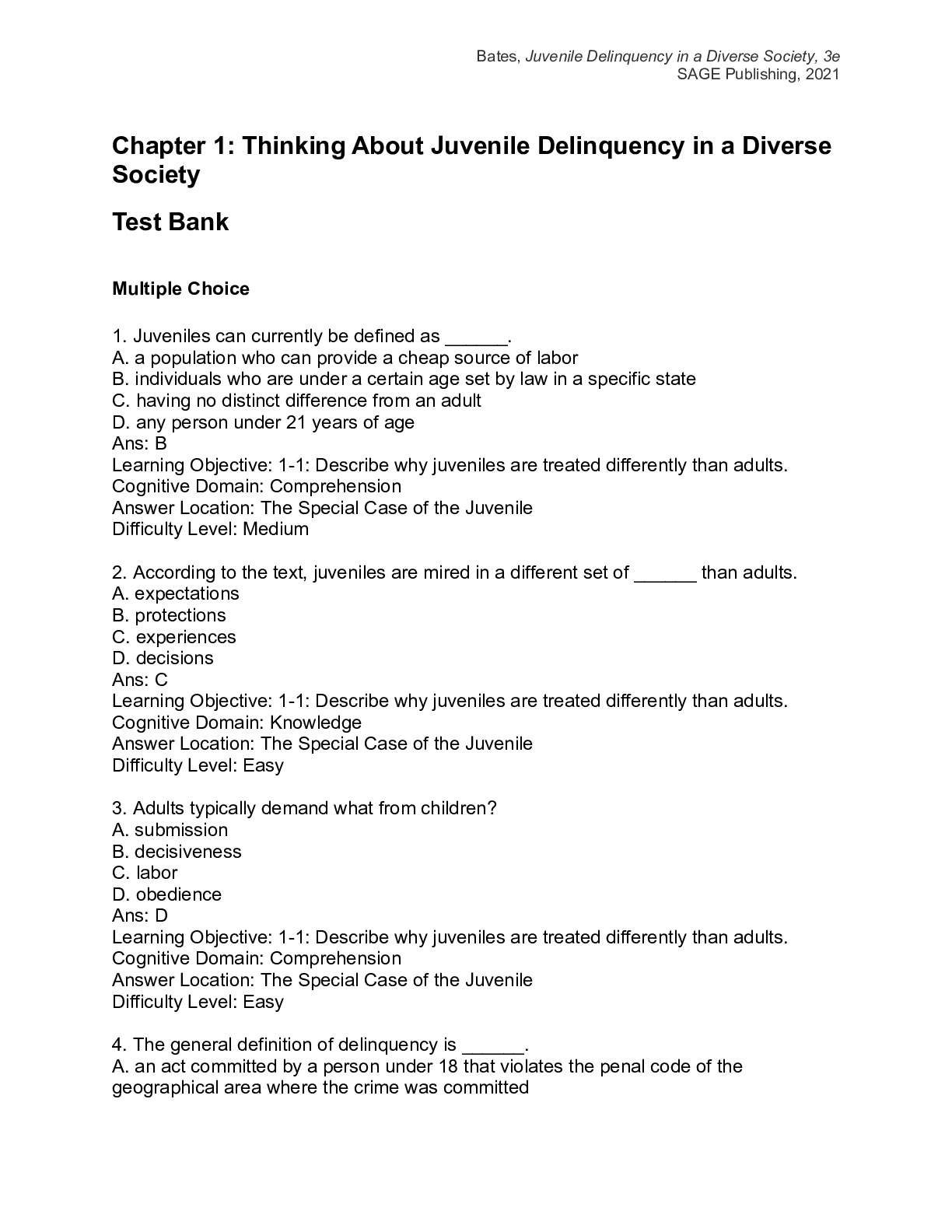
Reviews( 0 )
Document information
Connected school, study & course
About the document
Uploaded On
Sep 01, 2022
Number of pages
283
Written in
Additional information
This document has been written for:
Uploaded
Sep 01, 2022
Downloads
0
Views
150

